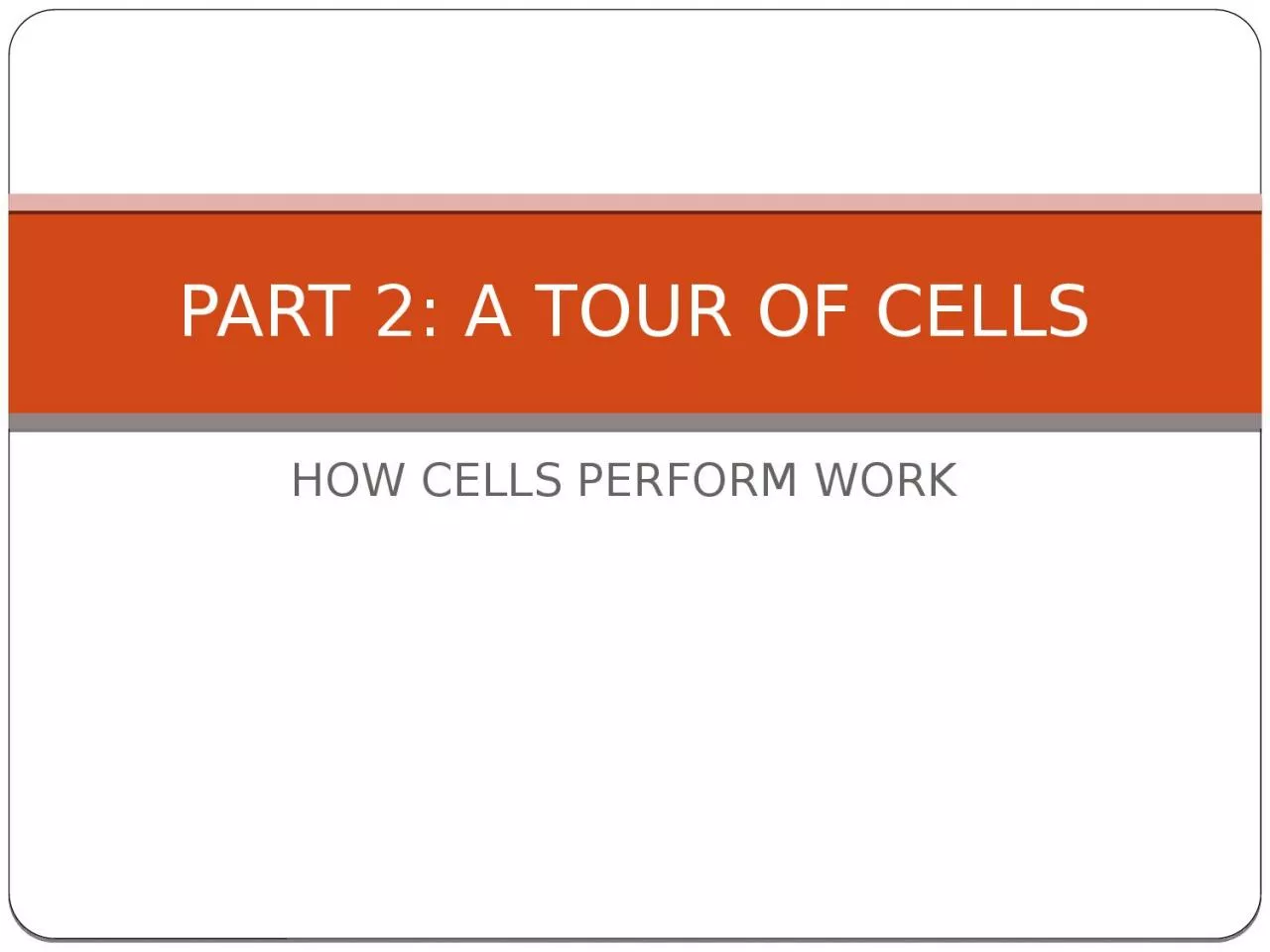

CELLULAR RESPIRATION MEMBRANE FUNCTION Working cells must control the flow of materials to and from the environment Membrane proteins perform many functions Transport proteins Are located in membranes ID: 1045214
Download Presentation The PPT/PDF document "HOW CELLS PERFORM WORK PART 2: A TOUR OF..." is the property of its rightful owner. Permission is granted to download and print the materials on this web site for personal, non-commercial use only, and to display it on your personal computer provided you do not modify the materials and that you retain all copyright notices contained in the materials. By downloading content from our website, you accept the terms of this agreement.
1. HOW CELLS PERFORM WORKPART 2: A TOUR OF CELLS
2. CELLULAR RESPIRATION
3. MEMBRANE FUNCTIONWorking cells must control the flow of materials to and from the environment.Membrane proteins perform many functions.Transport proteins Are located in membranesRegulate the passage of materials into and out of the cell
4. MEMBRANE PROTEINS
5. FRUCTOSE & GLUCOSE
6. PASSIVE TRANSPORT: DIFFUSION ACROSS MEMBRANESMolecules contain heat energy that causes them to vibrate and wander randomly.Diffusion is the tendency for molecules of any substance to spread out into the available space.Passive transport is the diffusion of a substance across a membrane without the input of energy.Diffusion is an example of passive transport.Substances diffuse down their concentration gradient, a region in which the substance’s density changes
7. DIFFUSION AND EQUILIBRIUM
8. MEMBRANE TRANSPORTACTIVE TRANSPORT (REQUIRES ENERGY)PASSIVE TRANSPORT(REQUIRES NO ENERGY)
9. THE ROLE OF MEMBRANESIN CELL SIGNALINGThe plasma membrane helps convey signals betweenCells Cells and their environmentReceptors on a cell surface trigger signal transduction pathways thatRelay the signal Convert it to chemical forms that can function within the cell
10. ADRENALINE
11. HOW VIRUSES MAKE PROTEIN
12. VIRUSES AND OTHER NON-CELLULAR AGENTSViruses exhibit some, but not all, characteristics of living organisms. Viruses:Possess genetic material in the form of nucleic acids Are not cellular and cannot reproduce on their own.
13. ADENOVIRUS STRUCTURE
14. BACTERIOPHAGESBacteriophages, or phages, are viruses that attack bacteria.Phages have two reproductive cycles.(1) In the lytic cycle:Many copies of the phage are made within the bacterial cell, and then The bacterium lyses (breaks open)(2) In the lysogenic cycle:The phage DNA inserts into the bacterial chromosome and The bacterium reproduces normally, copying the phage at each cell division
15. BACTERIOPHAGES CONT.2D AND 3D REPRESENTATION (2NM TALL)ELECTRON MICROSCOPE
16. LYTIC CYCLE
17. TOBACCO MOSAIC VIRUSSTRUCTURETOBACCO LEAF WITH TMV
18. ANIMAL VIRUSESViruses that infect animals are:Common causes of disease May have RNA or DNA genomesSome animal viruses steal a bit of host cell membrane as a protective envelope.The reproductive cycle of an enveloped RNA virus can be broken into seven steps.
19. INFLUENZA VIRUS
20. REPRODUCTIVE CYCLE OF ENVELOPED VIRUS
21. MUMPS VIRUS
22. THE PROCESS OF SCIENCE:VACCINATIONS AND THE ELDERLYObservation: Vaccination rates among the elderly rose from 15% in 1980 to 65% in 1996.Question: Do flu vaccines decrease the mortality rate among those elderly people who receive them?Hypothesis: Elderly people who were immunized would have fewer hospital stays and deaths during the winter after vaccination.Experiment: Tens of thousands of people over the age of 65 were followed during the ten flu seasons of the 1990s.Results: People who were vaccinated had a:27% less chance of being hospitalized during the next flu season and 48% less chance of dying
23. VACCINE RESULTS ON POPULATION
24. VACCINES
25. HIV: THE AIDS VIRUSHIV is a retrovirus, an RNA virus that reproduces by means of a DNA molecule.Retroviruses use the enzyme reverse transcriptase to synthesize DNA on an RNA template.HIV steals a bit of host cell membrane as a protective envelope.AIDS (acquired immune deficiency syndrome) is:Caused by HIV infection andTreated with drugs that interfere with the reproduction of the virus
26. HIV STRUCTURE
27. REV/RRE FUNCTIONRev/Rre FunctionHIV (in green) infecting lymphocyte
28. AZT
29. Viroids and PrionsTwo classes of pathogens are smaller than viruses:Viroids are small circular RNA molecules that do not encode proteins Prions are misfolded proteins that somehow convert normal proteins to the misfolded prion versionPrions are responsible for neurodegenerative diseases including:Mad cow diseaseScrapie in sheep and goatsChronic wasting disease in deer and elkCreutzfeldt-Jakob disease in humans
30. Prions continuedPrions are responsible for neurodegenerative diseases including:Mad cow diseaseScrapie in sheep and goatsChronic wasting disease in deer and elkCreutzfeldt-Jakob disease in humans
31. AVIAN FLUAvian flu:Infects birdsInfected 18 people in 1997Since has spread to Europe and Africa infecting 300 people and killing 200 of themIf avian flu mutates to a form that can easily spread between people, the potential for a major human outbreak is significant.New viruses can arise by:Mutation of existing viruses Spread to new host species